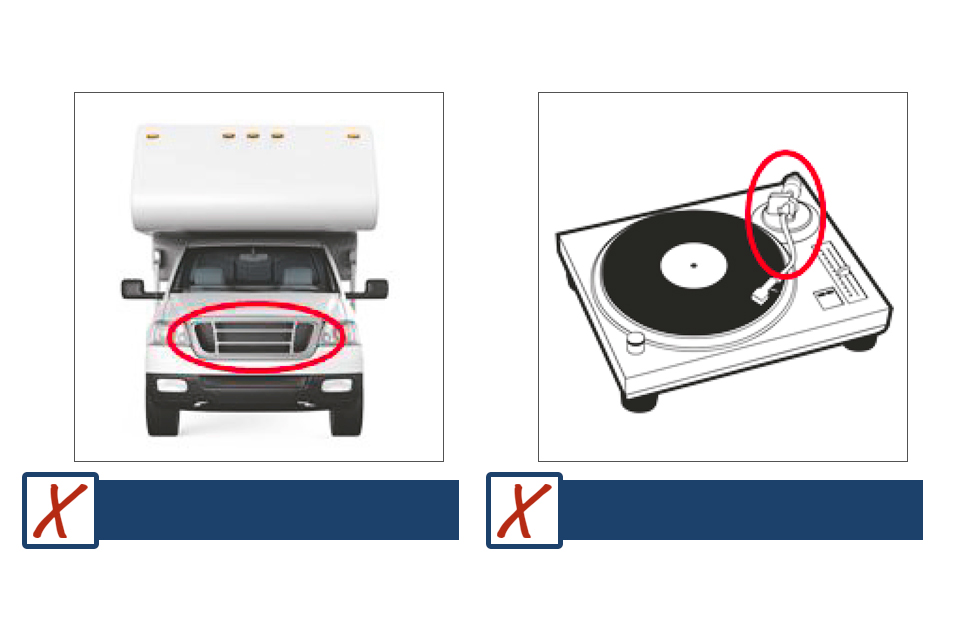Part C: Formalities
Includes chapters on applications, modification, priority and convention claims, illustrations and disclaimers.
7.01
Where an applicant has more than one design to protect, there is financial benefit in filing a multiple application. The same application form should be used when filing either a multiple or single application (form DF2A) although in the case of a multiple, it is imperative that the applicant lists the total number of designs at the relevant section (box 3 on the Form DF2A).
7.02
For paper-filed applications, there are no restrictions on the number of designs filed as part of a multiple application. However, for applications filed online, the number of designs is capped at 50. Each design contained within a multiple application will be examined on its own merits. This means that, in effect, each one will be treated as an independent design application.
7.03
Once designs applied for as part of a multiple application reach registration, they will exist on the register in their own right, and will be treated separately for the purpose of all post-registration actions including renewal periods and the payment of renewal fees.
7.04
A design application must specify the product to which the design is intended to be applied to, or into which it is to be incorporated. Therefore, for example, if the indication of product states ‘clothing’, it may be that the representation shows a logo. This is acceptable. The logo is to be applied to clothing which may consist of a ‘T-Shirt’ etc. Where the design is being applied to a car headlight, a suitable indication of product could be simply ‘car headlight’, or alternatively, ‘automobile’ or ‘car’ would also be acceptable as that is the product the design is intended to be applied to or incorporated within. Therefore, the page headed ‘ About the design - What product is your design going to be used on or incorporated onto?’ on the electronic DF2A should state ‘clothing’, or any other simple and straightforward reference to the product the design is to be applied to, or incorporated on.
7.05
A formalities objection will be raised under Rule 5(2) if the indication of product consists of only a model name, serial number or trade mark under which the design is to be marketed. This is because the examiner will not be able to correctly classify the design. Where an objection is raised a period of two months will be allowed for the applicant to supply an acceptable indication of product. Failure to do so will result in the application being refused.
7.06
It should be emphasised that compliance with Rule 5(2) (that is the provision of a statement specifying what the design is intended to be applied or incorporated into) is solely for the purposes of the application process. The ‘indication of product’ does not limit the scope of protection conferred by the registration. This approach is confirmed in paragraph 93 of the judgement of the Court (Fourth Chamber) in joint cases C-361/15 P and C405/15 P (Easy Sanitary Solutions v Group Nivelles NV):
….that a registered Community design confers on its holder the exclusive right to use the relevant design in all types of products, and not only in the product indicated in the application for registration.
Paragraph 94 goes on to say:
Under Article 36(6), the information referred to, inter alia, in paragraph 2 of that same Article is not to affect the scope of protection of the design as such. Consequently, that information, consisting of an indication of the products in which the design is intended to be incorporated or to which it is intended to be applied, cannot limit the protection of that design, as is provided for, in particular, in Article 10 of Regulation No. 6/2002.
7.07
In accordance with the secondary legislation, applicants are permitted to include a brief description of the design within the application form, although this is not a mandatory requirement. Any such description must avoid the inclusion of technical data (such as, for example, a written explanation of how the design fits or works), and this section of the application form should not be seen in any way as an opportunity to claim aspects of a product’s functionality. This section may also be used to explain the inclusion of view designations etc. so as to further clarify the nature of the design intended for protection (see ‘disclaimers’ section at paragraphs 12.01 to 12.14 below).
7.08
Although the RDA and the Rules allow for the filing of specimens as part of the application process, it should be noted that a two-dimensional representation of the design is still required in all cases. The Registrar does not deem a ‘specimen’ to constitute a representation which is ‘suitable for publication’ as required by Rule 9, and so the submission of specimens alone will always be deemed insufficient. Specimens must be complemented by conventional two-dimensional representations.
7.09
Examiners will neither request nor accept a specimen in place of clear representations. It is up to the applicant to comply with Rule 9 and provide representations which are suitable for publication, thereby ensuring that third parties viewing the register are clear as to where the registered rights lie (see Hadley Industries v Sloggett [2003] EWHC 2361).
8.01
Sections 3B(1) and 3B(2) of the RDA set out the grounds under which the Registrar may permit the modification of a design following the filing of replacement representations:-
| Sections 3(B)(1) and (2) of the RDA state: |
| (1) The registrar may, at any time before an application for the registration of a design or designs is determined, permit the applicant to make such modifications of the application as the registrar thinks fit. (2) Where an application for the registration of a design or designs has been modified before it has been determined in such a way that any design included in the application has been altered significantly, the registrar may, for the purpose of deciding whether and to what extent the design is new or has individual character, direct that the application so far as relating to that design shall be treated as having been made on the date on which it was so modified. |
8.02
Where representations submitted with the design application are deemed to be unclear, an objection will be raised under Rule 9. The applicant will then be given an opportunity to modify the original representations in accordance with Section 3B.
8.03
Where replacement representations are provided but are found to contain additional elements, or show a design which has a different overall appearance and identity from that disclosed in the application from, it will be necessary for the application to be re-dated. In such scenarios, the filing date will be altered to reflect the date on which representations which are suitable for publication were received by the Registrar.
8.04
Sections 3B(3), (4), (5) and (6) of the RDA set out the grounds under which an application that contains more than one design can be divided:-
| Sections 3B(3), (4), (5) and (6) of the RDA state: |
| Where- (a) An application for the registration of more than one design has been modified before it has been determined to exclude one or more designs from the application; and (b) A subsequent application for the registration of a design so excluded has, within such period (if any) as has been prescribed for such applications, been made by the person who made the earlier application or his successor in title, the registrar may, for the purpose of deciding whether and to what extent the design is new or has individual character, direct that the subsequent application shall be treated as having been made on the date on which the earlier application was, or is treated as having been, made. (4) Where the registration of a design has been refused on any ground mentioned in section 3 A (4) (b) or (c) of this Act, the application for the design may be modified by the applicant if it appears to the registrar that- (a) The identity of the design is retained; and (b) The modifications have been made in accordance with any rules made under this Act. (5) An application modified under subsection (4) above shall be treated as the original application and, in particular, as made on the date on which the original application was made or is treated as having been made. (6) Any modification under this section may, in particular, be effected by making a partial disclaimer in relation to the application. |
8.05
Where a single design application contains multiple images which clearly denote more than one design, the examiner will identify the different designs (submitted as part of the initial application), and will request that the application either be limited to one design, or divided into further applications as provided for under Section 3B.
8.06
Where the applicant chooses to divide their initial application into further applications, the ‘additional’ design(s) must be resubmitted - via Form DF2B - as a separate application(s), and must be accompanied by payment of the required fee. They will then be linked with the ‘parent’ application, and assigned the same registration and renewal dates.
9.01
Prohibition or restriction of publication
Section 5 of the RDA sets out provisions related to secrecy for certain designs deemed to be relevant for defence purposes. The power of section 5(1) allows that the registrar may give directions, in cases where a design is one of a class of goods notified by the Secretary of State as relevant for defence purposes, such as; ‘weaponry’, ‘tanks’ and ‘military vehicles’ and ‘other’ defence products, to prohibit or restrict the publication of information in respect of the design. The registrar may also communicate such information to any person or class of person specified in section 5(3).
9.02
If it is determined that the publication of the design would be prejudicial to the defence of the realm, and where no authorisation has been given to the registrar contrary to that view, the registrar shall reconsider the question within nine months from the date of filing of the application for registration, and at least once in every subsequent year. Where it is considered that publication of the design would no longer be detrimental to the defence of the realm, the Secretary of State shall inform the registrar. On receipt of such notification the registrar shall revoke the direction. The registrar may then extend the time for doing anything required, or authorised, to be done by, or under the Act in respect of the application for registration, whether or not that time has previously expired.
Section 5(4) refers to applications for such designs being submitted outside of the United Kingdom, and establishes the need for an applicant to obtain a written permit prior to submitting any such overseas application
Notwithstanding the content of Section 5, applicants should note that a UK resident no longer requires authorisation of the Registrar, nor need await security vetting of an application to register the same design in the UK before applying to register a design abroad (see notice published on 26 October 1994 in the Official Journal 5450 refers).
10.01
Sections 14(1) and 14(2) of the RDA set out the grounds under which an applicant may make a claim where an application for protection in a convention country has been made:-
| Sections 14(1) and (2) of the RDA state: |
| (1) An application for registration of a design or designs in respect of which protection has been applied for in a convention country may be made in accordance with the provisions of this Act by the person by whom the application for protection was made or his personal representative or assignee: Provided that no application shall be made by virtue of this section after the expiration of six months from the date of the application for protection in a convention country or, where more than one such application for protection has been made, from the date of the first application. (2) Where an application for registration of a design or designs is made by virtue of this section, the application shall be treated, for the purpose of determining whether (and to what extent) that or any other design is new or has individual character, as made on the date of the application for protection in the convention country or, if more than one such application was made, on the date of the first such application. |
10.02
An applicant has three options when seeking to claim priority from an earlier application. The first option is to confirm, at application stage, that the design contained in the priority claim is identical to the UK design application. This can be done by following the instructions supplied on the electronic application.
10.03
The second option is to file a declaration on a DC1. Under Rule 7(4), claims to priority as set out in Section 14 of the RDA must be verified ‘to the satisfaction of the registrar’. To meet this requirement, and to simplify procedures for applicants, examiners will assume good faith and accept a completed DC1 as confirmation that the design filed as an earlier convention application is identical to the corresponding design in the UK application. If subsequent legal proceedings identify that the designs are not identical, there is a risk that the priority claim may be forfeited.
10.04
Where an application claiming priority has been submitted without a Form DC1, the applicant will have three months from the date of filing of the UK application in which to provide the Registrar with either a completed form or a certified copy of the priority document. Where a priority document is filed in a language other than English, the examiner may also request a certified translation. In relation to multiple applications filed on a single Form DF2A, only one Form DC1 is required to cover all the designs contained within the ‘multiple’ application.
10.05
The third option is to the provide IPO with a certified copy of the convention document. This may be supplied in hard copy or via email to designsexamination@ipo.gov.uk. On receipt, the examiner will check to ensure that the representation(s) for the earlier case and the application are identical, and that the filing date and applicant details also match. If the two designs do not meet the aforementioned criteria, the examiner will raise an objection. Where the applicant is then unable to satisfy the examiner that the claim is valid, the priority claim will be refused.
10.06
Under UK design law, there is no provision for recognising utility models. As a result, proof of filing a utility model cannot be used as a basis for claiming priority under Section 14 RDA in respect of a UK Registered Design application.
10.07
Although it is rare for extensions of time to be provided in respect of the submission of priority documents, the Registrar may, in exceptional circumstances, allow additional time. Each decision will be made on a case-by-case basis. Applicants should note that guidance provided in this paragraph relates solely to the submission of documents for substantiating a claim to priority. It does not apply to requests to extend the actual six month period for claiming priority as set out in section 14 RDA.
11.01
Rule 4 sets out the filing requirements for a design application, with Rule 4(1)(b) in particular highlighting the need for a representation of the design to be included in any such application. Although there are different means of representing a design in two-dimensional form (line drawings, photographs, computer graphic rendering), any representation(s) used should always be clear and well-defined - so as to permit third parties and other Registering Authorities to identify with relative ease what has actually been registered. It should be noted that for any one single design application, an applicant may submit up to twelve representations using the digital service, and unlimited representations using the paper form.
11.02
Representations in the form of drawings should be of good quality, with clear and dark lines, and should always be capable of being reproduced so that the features of the design remain clearly visible to third parties. Where photographs are used, it is recommended that they also be of good quality, enabling all features of the design to be clearly visible and suitable for reproduction. Regardless of the type of representation used, the following guidance should always be taken into account
-
avoid representations which contain undefined or poorly-defined areas of the design due to lack of lighting
-
avoid glare on shiny, reflective or transparent surfaces
-
avoid blurring, unless it is being used intentionally as a visual disclaimer (see paragraph 12.11 below)
-
ensure strong tonal contrast between design and background
-
avoid representations which show visible and obvious deletions or corrections
-
when a design is unsuitable for being represented as a photograph (for example, where the product is made of a transparent material), then one should use alternative forms of representation such as drawings or graphic renderings
11.03
Where the examiner finds that representations are not of a suitable quality, an objection will be raised under Rule 9(1)(b). A period of three months will then be granted for the applicant to submit replacement representations which should be suitable for publication.
11.04
A design should be represented using only one visual format (drawing, graphic rendering or photograph) so as to avoid disclosing aspects that contribute to a different overall impression. Where multiple representation formats are used in a single application, each representation must clearly and obviously relate to the same design and be consistent in terms of the features disclosed. Failure to meet such criteria is likely to result in division of the application into two or more designs pursuant to Section 3B(3) RDA. In the following example, the representation on the right clearly displays wood graining which contributes to the design’s overall impression. Such features are not visible in the design shown on the left, which is presented as a simple line drawing. Each of these two designs is different, meaning that a single application consisting of such representations would be objected to, and the applicant invited to divide it into two separate designs or limit to one:

(Where both are submitted as a single design application)
11.05
The impact of visible detail presented in certain types of design representations was brought to the fore in the Supreme Court’s judgment in PMS International Limited v Magmatic Limited [2016] UKSC 12 (‘Trunki’)(PDF,343 KB). In the judgment, emphasis was placed on the distinction between those designs which are intended to protect shape alone, and those which are intended to protect both shape and other features.
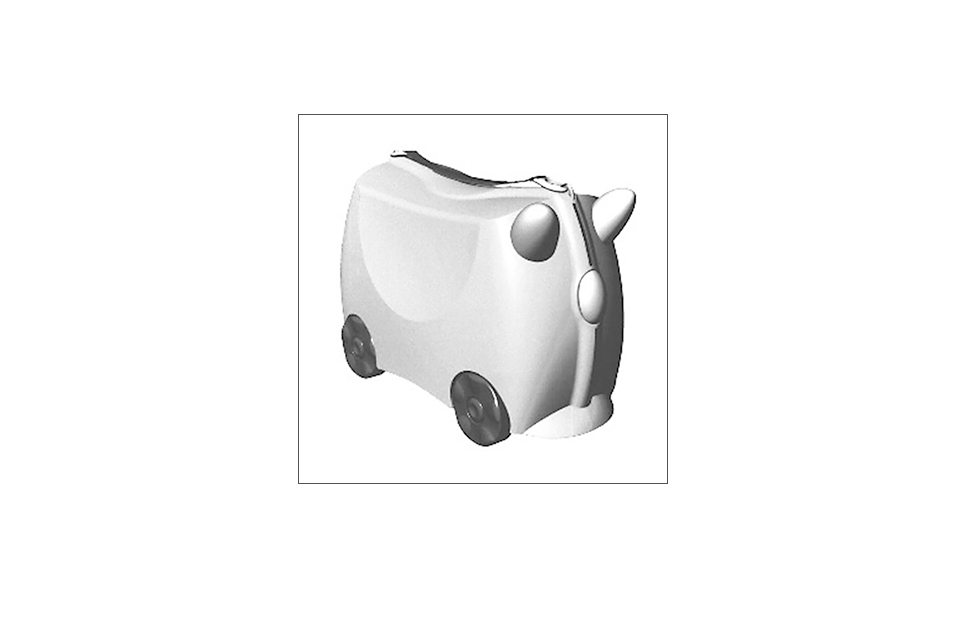
11.06
In Trunki, the Court assessed the greyscale representation shown above and concluded that its minimal levels of tonal differentiation were enough to result in the design not being a claim to shape per se, but rather being a claim to shape incorporating certain elements (the wheels and the strap, for instance) which are coloured in a manner which contrasts with other features of the shape. In short, the claim was for more than shape alone.
11.07
The decision demonstrates why a CAD representation such as the one shown above would not be accepted alongside a simple line drawing of the same product when both representations are used as part of the same application. More information on the Trunki judgment and the use of different types of representation can be found in Designs Practice Notice (‘DPN’) 01/16.
11.08
Section 1(2) RDA confirms that colour(s) can be a feature of a registered design see paragraph 2.04). Reflecting that provision, representations filed as part of a design application can be submitted in pure black-and-white, in greyscale, or in colour. It should be noted that, as is the case with combinations of representation formats, single applications which contain combinations of different-coloured and/or non-coloured designs will be subject to an objection due to the different overall impression created by each representation. In such cases, the applicant will be instructed to either withdraw some of the coloured views, or to divide the application.
11.09
The background against which the design is shown will be considered neutral as long as the design is clearly distinguishable from its environment without any reference to other objects, accessories, decoration or written text. Any representation which does not consist of a neutral background, and where the design is not clearly distinguishable, will be open to objection under Rule 9(1)(b).
11.10
In order to assess whether or not a background is neutral, applicants should take into account factors such as coloration, contrast and shadow, all of which may have an unintended effect on the appearance of the design. In respect of background coloration, a single or predominant colour will always be acceptable if it stands out against the colours of the design intended for protection (that is if there is a clear contrast between the two). The following are two examples where single-coloured backgrounds are suitable and acceptable on account of their strong contrast with the designs presented in the foreground:
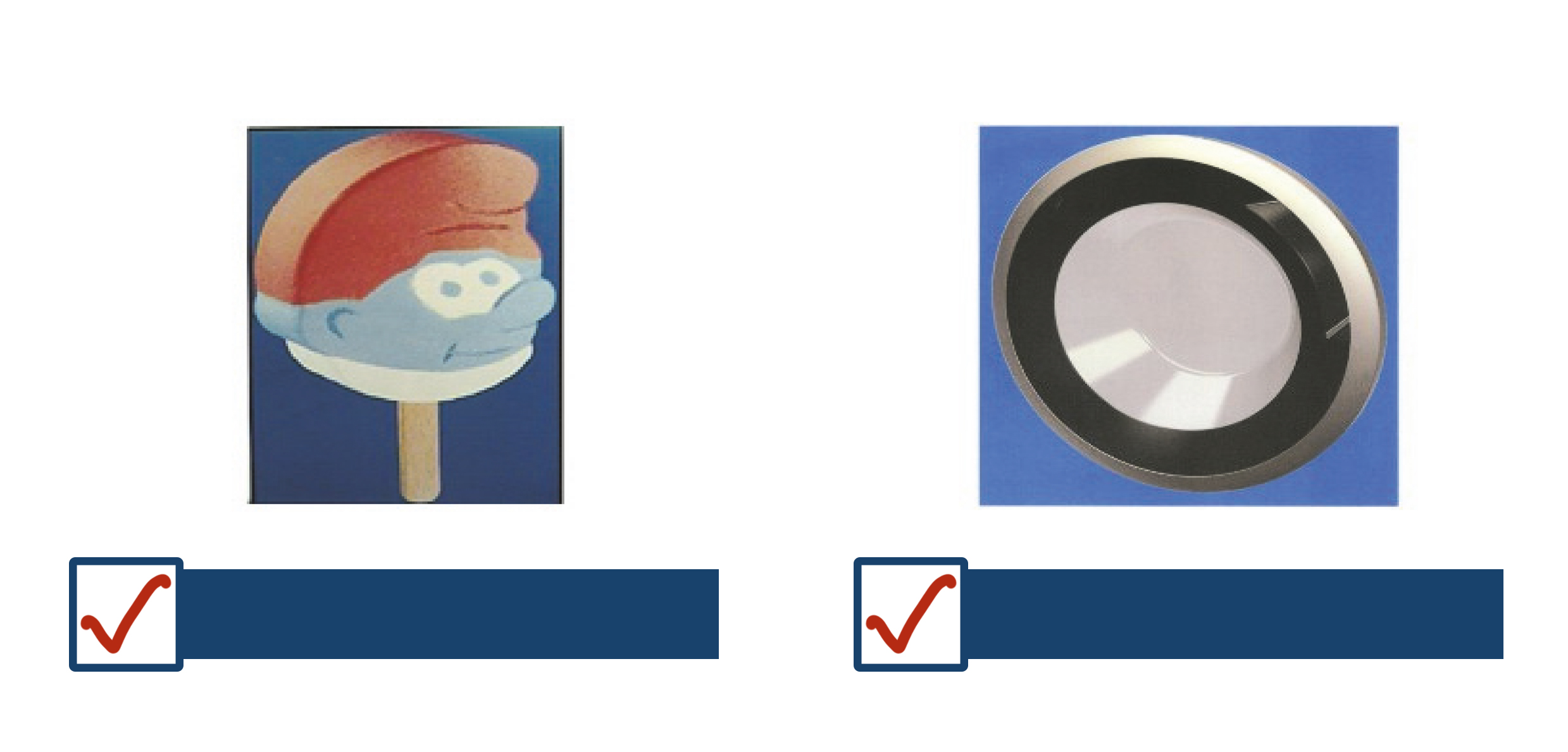
11.11
In contrast, the following are two examples of unacceptable single-coloured backgrounds. In both cases, the colours used as background are near-identical to those used in the items presented in the foreground:

11.12
The following two examples show designs being presented against a ‘predominantly coloured’ (as opposed to a single block colour) background. In these cases, although the displayed background materials no longer consist of a simple block colour, neither interferes with the representation of the product intended for protection. As a result, both of the following are acceptable:
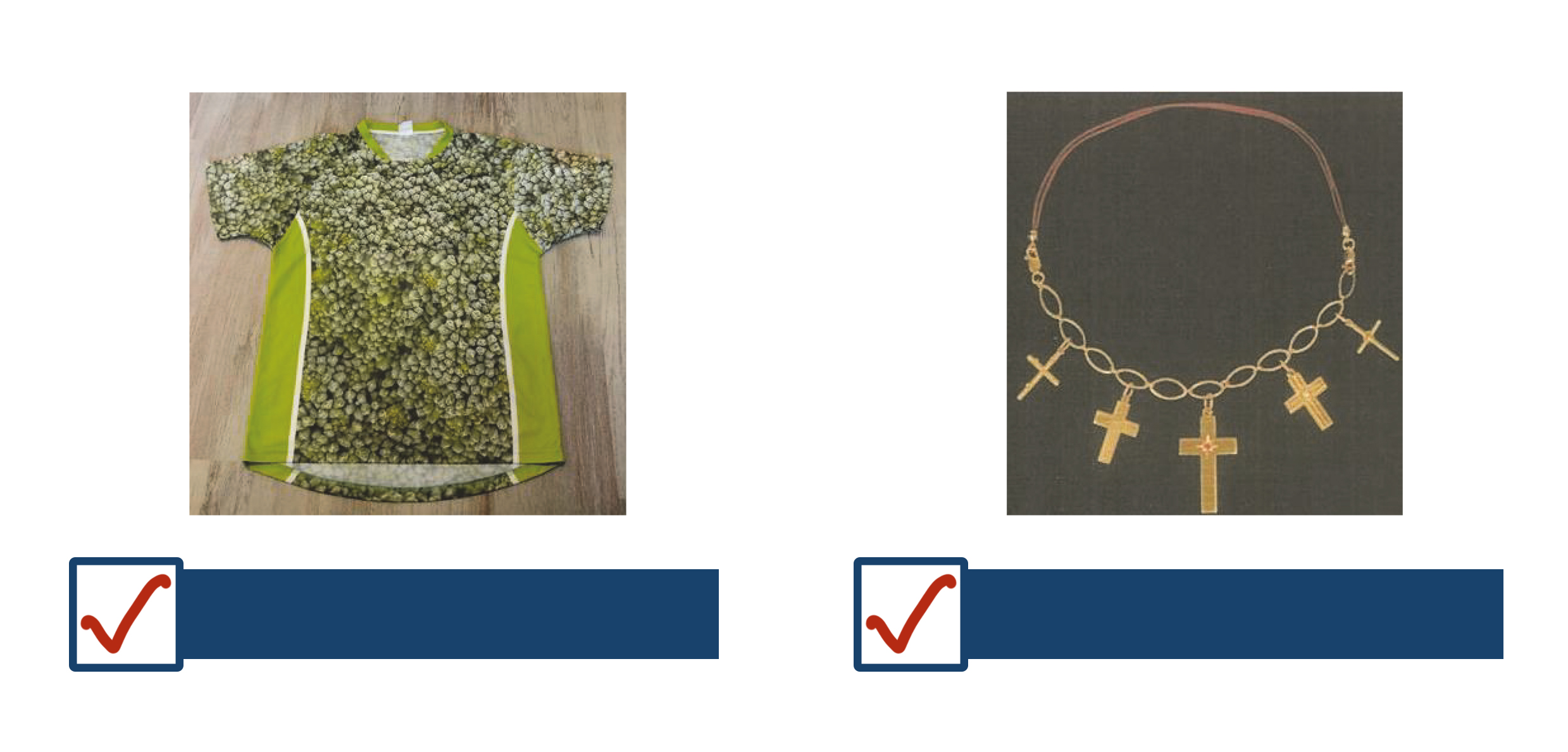
11.13
The following example also shows a design where the background material is presented in a ‘predominantly coloured’ background (which appears to be a type of textile). However, in this case, the similarity in colour between the heart-shaped item and the background, combined with the ‘ridges’ also visible in the background, means that the design intended for protection is not easily identifiable. As a result, this representation would be deemed unacceptable:
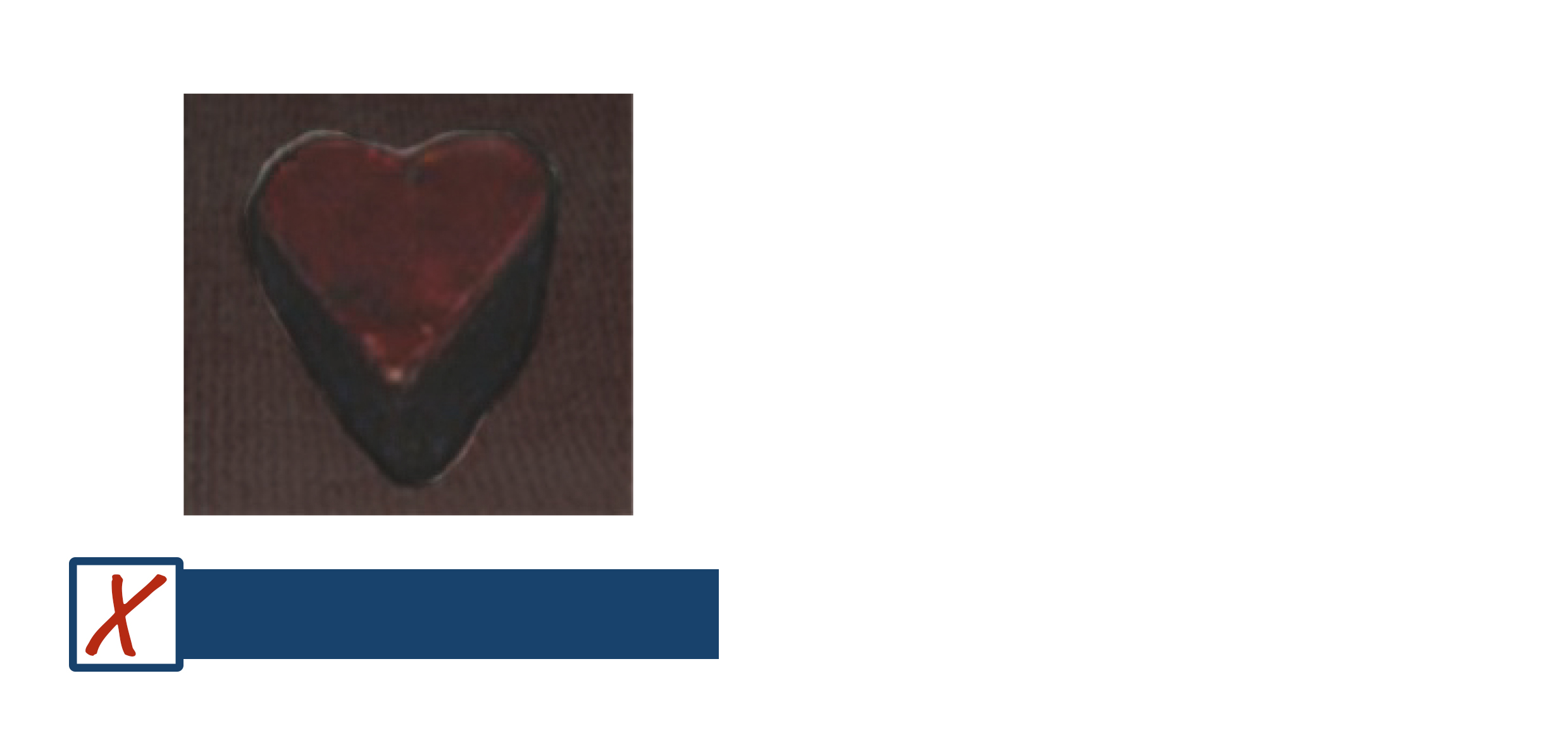
11.14
The use of graduations in colour and/or the use of multiple colours and/or shades within a background are acceptable provided that the design itself remains clearly distinguishable. The three designs shown below all use graduating/multiple colour backgrounds and are considered acceptable:

11.15
All features of the design should be clearly visible. A dark-coloured or shaded background can assist where the design intended for protection is presented in light colour or shading, and vice versa for dark-coloured designs. The use of colour or tonal contrast is considered insufficient where the colour of the design and the colour of the background are so similar as to make it difficult to distinguish between the two (that is it is not clear where the product finishes and the background starts). The following acceptable example shows sufficient contrast between the product and the background:

11.16
In contrast, the following three examples all fail to show sufficient contrast, and so are deemed to be unacceptable:
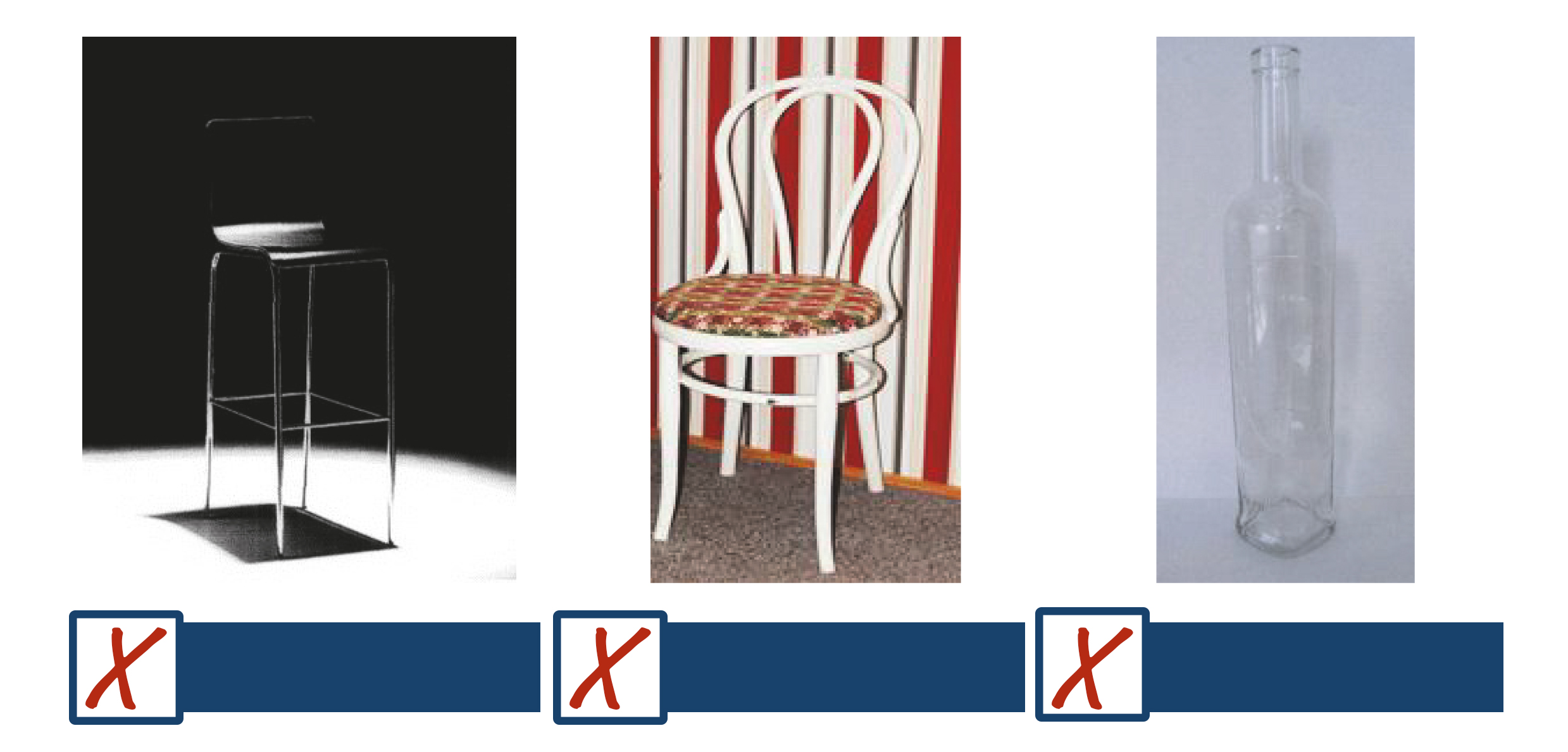
11.17
The presence of shadow and/or reflection in representations is acceptable provided that all features of the design remain visible. The following are examples where the presence of shadow and reflection does not interfere with the clarity of the design, and so these representations would be deemed acceptable:

11.18
Shadowing and/or reflection may render a representation unacceptable where it limits the colour or tonal contrast, or where it interferes with, hides parts of, or distorts the contours of the item intended for protection. In the following two examples, shadowing interferes to an extent that it is impossible to identify the exact nature of the designs:
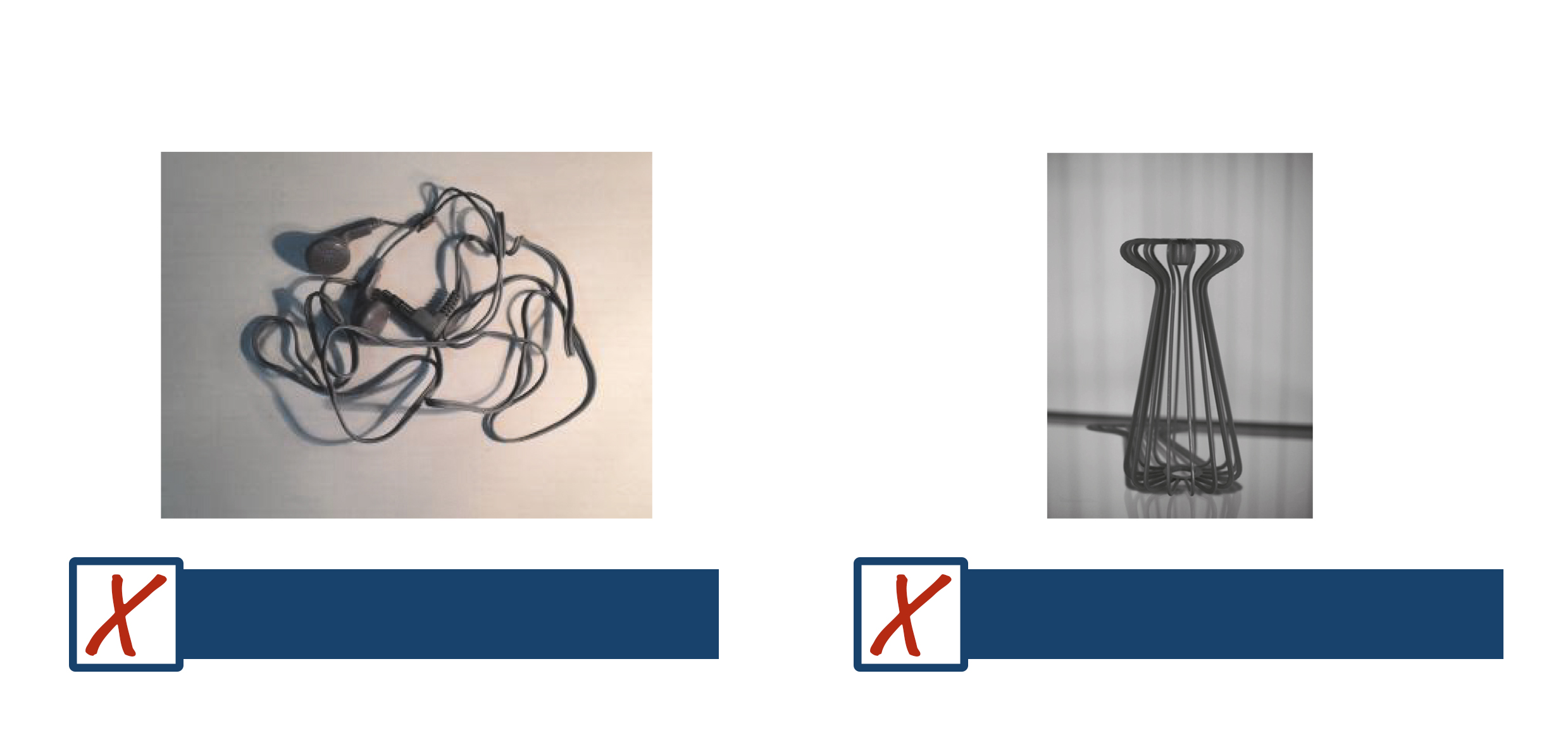
11.19
The following is deemed to be acceptable. Although light reflection is visible, the design/product is clearly identifiable:
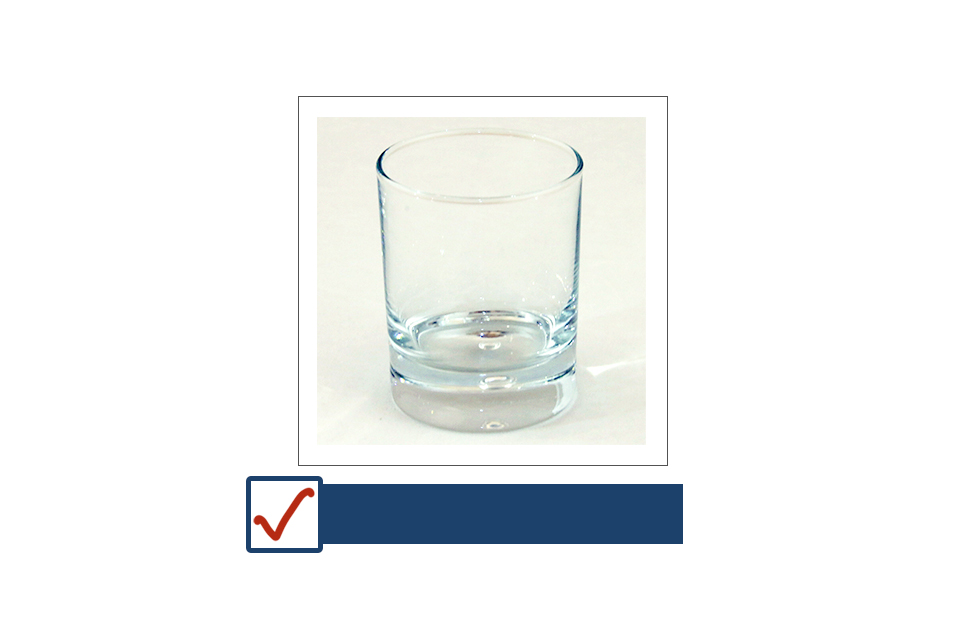
11.21
For the same reasons as those given in respect of applications which use different representation formats and/or different colours (see paragraphs 11.04 - 11.07 above), all representations filed within a single application must show the same design. For example, an application containing numerous representations of a single bottle shown in different sizes will be open to objection under Section 1(2) of the Registered Designs Act 1949 if the shape and proportions differ and they are no longer identical.
11.22
Likewise, an objection will be raised under s.1(2) RDA in cases where multiple hand-drawn representations have been provided, and it appears that the proportions of the design are not accurately consistent across the different views. The applicant will be given the opportunity to provide representations where the views are consistent with one another, to limit the application to a single view, or to divide the application as appropriate. This will also be the case where, in the context of a hand-drawn set of representations, it appears that features are missing from some views but not others. In all cases, it should be noted that the resubmission of replacement representations may result in the application being re-dated, pursuant to Section 3B(2) RDA.
11.23
Aspect views show the design from certain angles and may include some or all of the following: ‘front view’; ‘top view’; ‘bottom view’; ‘right side view’; ‘left side view’; ‘back view’; and ‘perspective view’. In the context of multiple aspect views, applicants should note that the maximum permitted number of views for a single design is set at twelve. The following example presents a single product (a food mixer) via seven different views. These would be acceptable when used in the context of a single application:

11.24
Although it is recommended that an applicant should file as many views as necessary in order to fully disclose the features of the design (up to a maximum of twelve), in some cases one view can be perfectly sufficient. The following examples illustrate how one representation can be enough to accurately represent the item intended for protection:

11.25
Magnified views show one part of an overall design on an enlarged scale, and can be used to highlight certain design features which may not be as clearly presented in a representation of the product in its entirety. Such views are acceptable provided they are accompanied by a representation of the whole product (that is with the magnified part being shown in context), and provided that the magnified part corresponds exactly to what is shown in the complete view. It is also imperative that the magnified view is presented as a separate representation, rather than being incorporated into a single representation showing the whole item. In the following acceptable example, two separate representations have been submitted in the context of a single application. The image on the left shows the whole design (including the magnified part in context) whilst the (separate) image on the right shows the ‘magnified’ view in isolation:
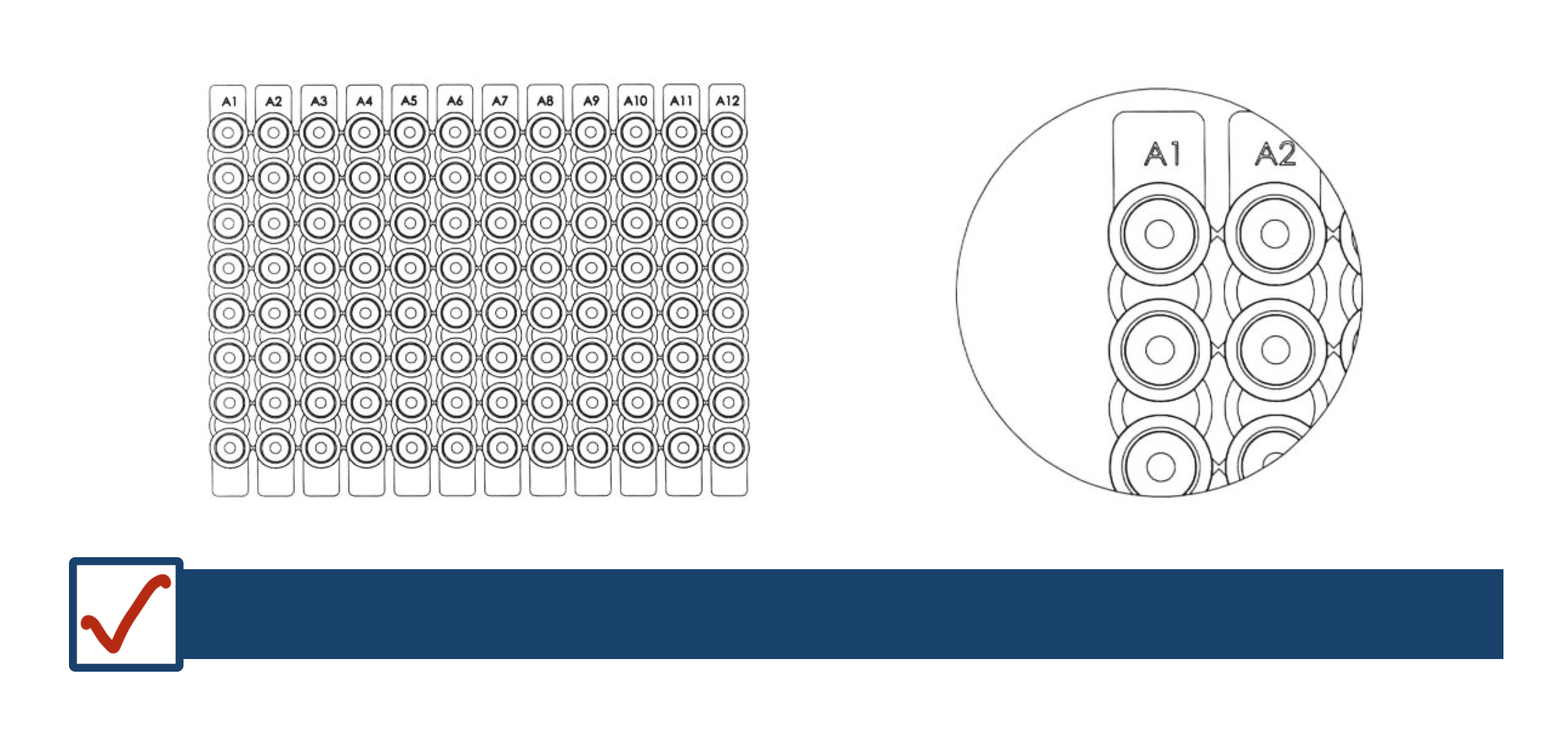
11.26
By contrast, in the following example the magnified section and the whole design in context are presented as a single representation. This type of ‘combined representation’ compromises the objectivity and clarity of the design intended for protection, and may distort third parties’ perception of what exactly is protected (it is unclear as to whether the ‘line and circle’ elements are intended to form part of the design). Therefore, the following representation would be rejected by the examiner:
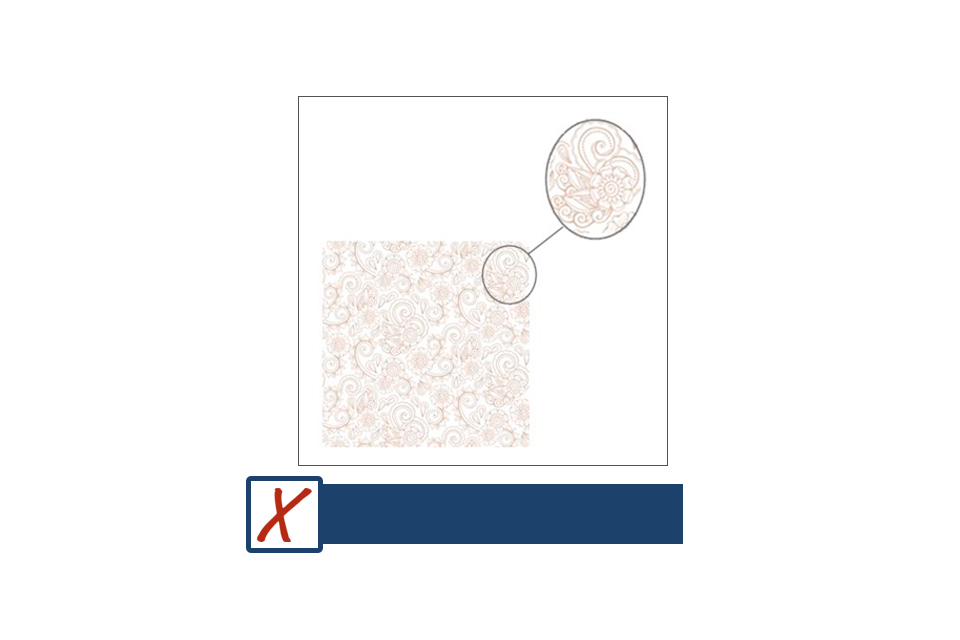
11.27
Alternative positions and/or transformable designs are those with an appearance which can be modified into several configurations without addition or removal of parts. Some designs have pre-defined ‘stages of use’ and so can be represented in different configurations. In the case of a clamshell-style mobile phone, for example, the product can be represented in both open and closed configurations, with each configuration referred to as being an ‘alternate position’. Other designs permit a multiple number of different configurations by the user, sometimes to the extent that one product can ‘transform’ into another (consider, for example, a travel bag which converts into a hand towel). Designs of this type are referred to as being ‘transformable’, and are acceptable as a single design.
11.28
Representations showing such ‘transformable’ designs will be accepted provided that no removable parts are either added or taken away. It should be noted that any representations provided must show each view of the design separately (for example one image per representation). The following are examples of acceptable ‘transformable design’ views showing single products configured in alternate positions (where each view of the configurable design is submitted as a separate representation within the context of a single application):


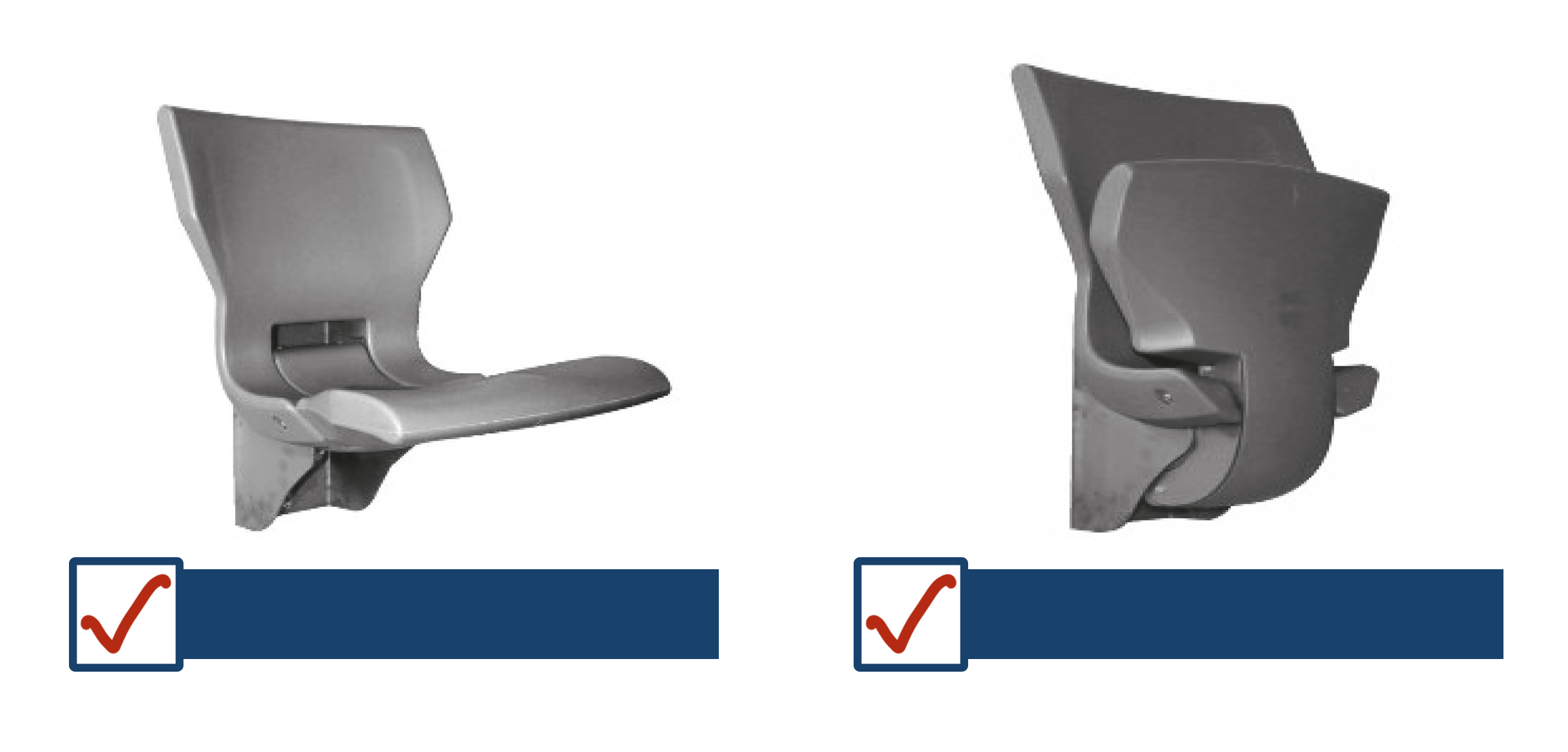
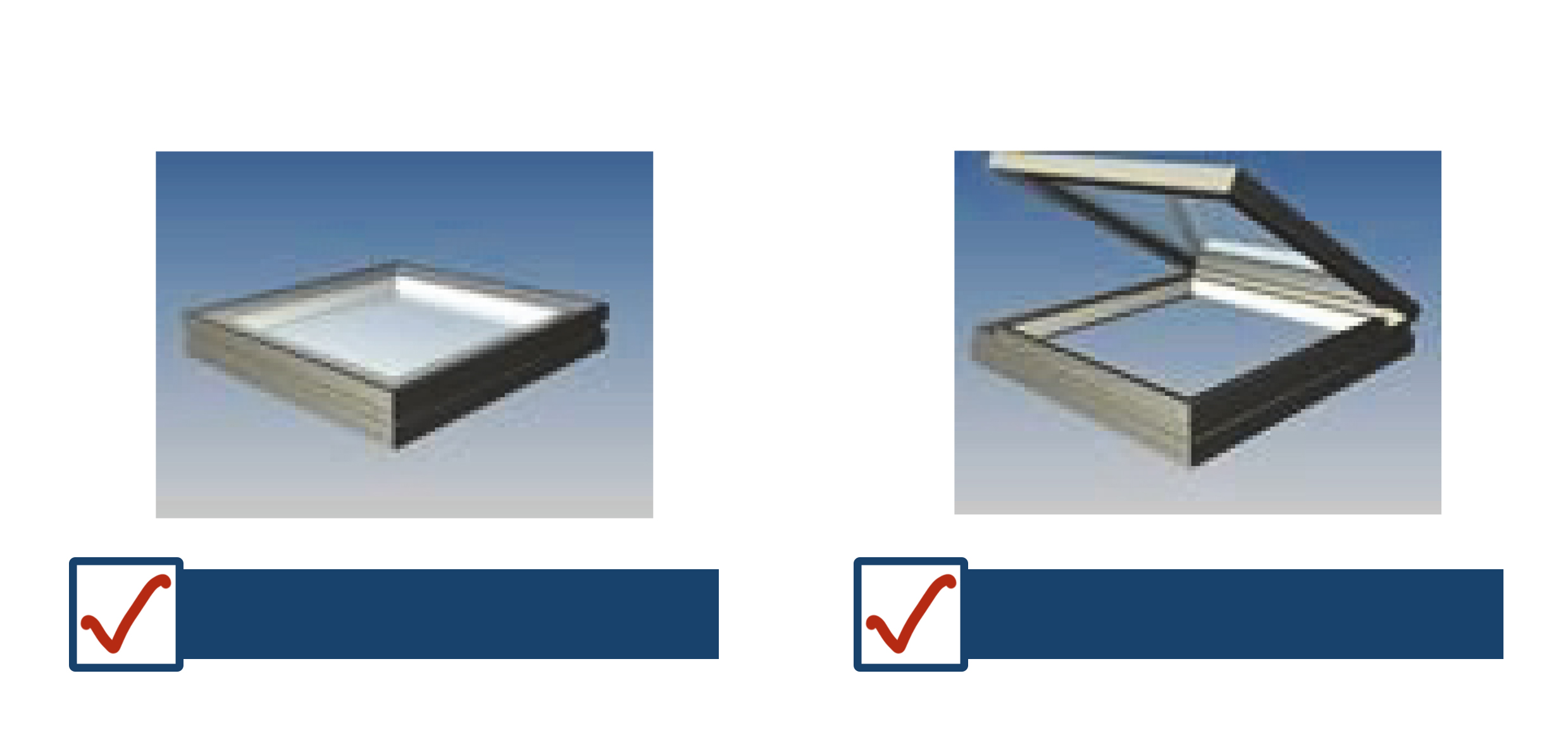
11.29
The following is an example of an unacceptable ‘transformable design’ and relates to an attempt to register the ‘travel bag-into-hand towel’ product referred to at paragraph 11.28 above. Although the design is shown in alternative positions, the applicant has submitted the numerous images as one single representation rather than as separate representations:
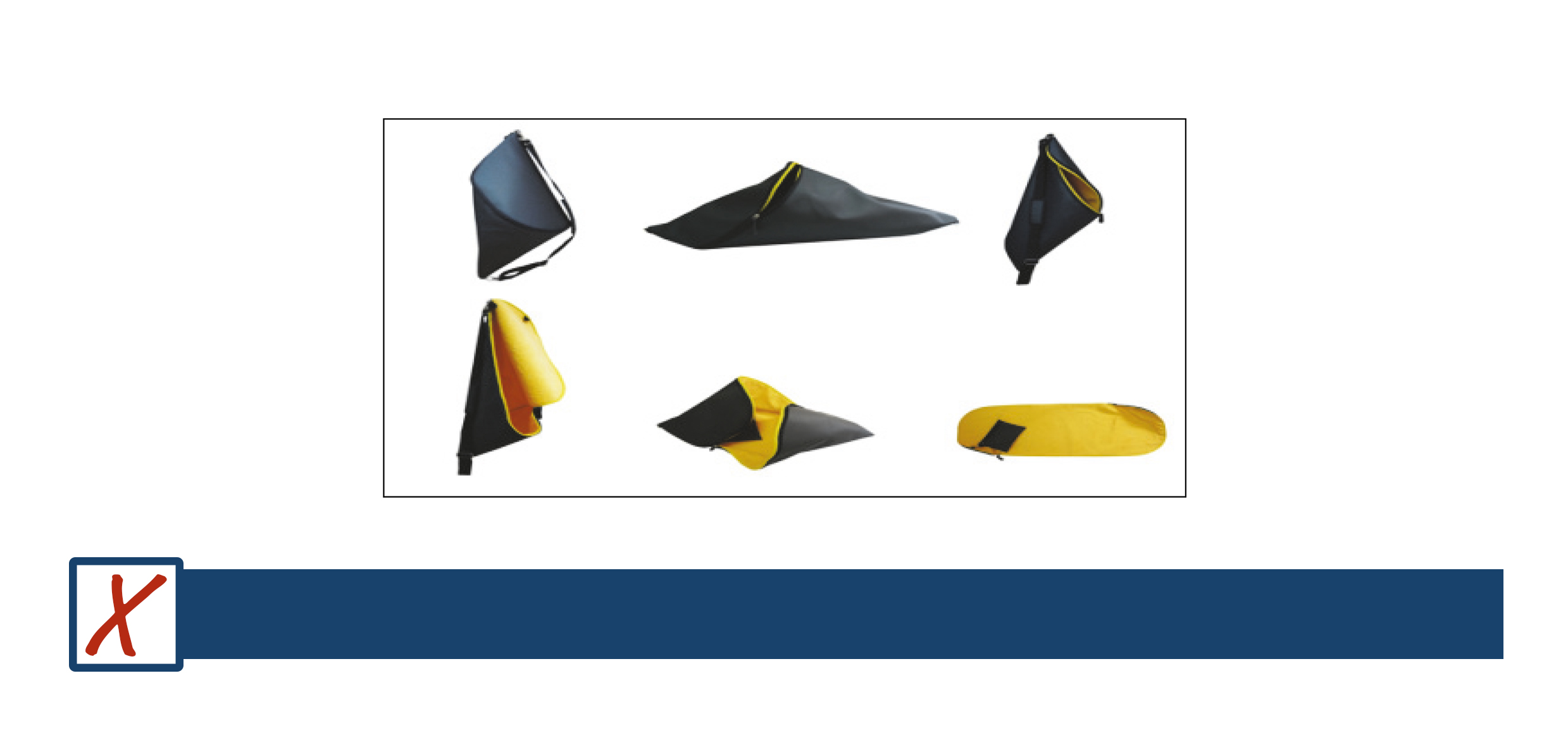
11.30
It should be noted that, following the IPO’s introduction of an electronic system for filing and processing Registered Designs, the new digital application form permits the uploading of up to twelve separate representations for each individual application. However each representation must itself contain only one single image, thereby ensuring that the applicant, the Registrar and third parties can identify the design and the protection conferred with relative ease.
11.31
An ‘exploded view’ consists of a representation showing a product with its parts disassembled, and is normally submitted in order to better illustrate how multiple parts fit together in order to form a single article. As is the case with ‘magnified’ views (see paragraphs 11.26 to 11.27 above), exploded views must always be accompanied by a representation showing the assembled product. The following example shows an acceptable ‘assembled’ view of a rollerball deodorant alongside a separate representation of an exploded view of that product. This view shows the constituent parts of the deodorant packaging being the lid, the roller ball, the cup that holds the roller ball and the container for the deodorant itself:

11.32
A ‘partial view’ is a view showing part of a product in isolation which can, if required, be magnified. As with exploded views, partial views must be combined with at least one view representing the whole product. This can also apply to component parts of complex products, where there must be at least one view representing the product assembled (that is the different components need to be shown connected to each other). The following shows an acceptable representation consisting of three partial views together with an assembled view:
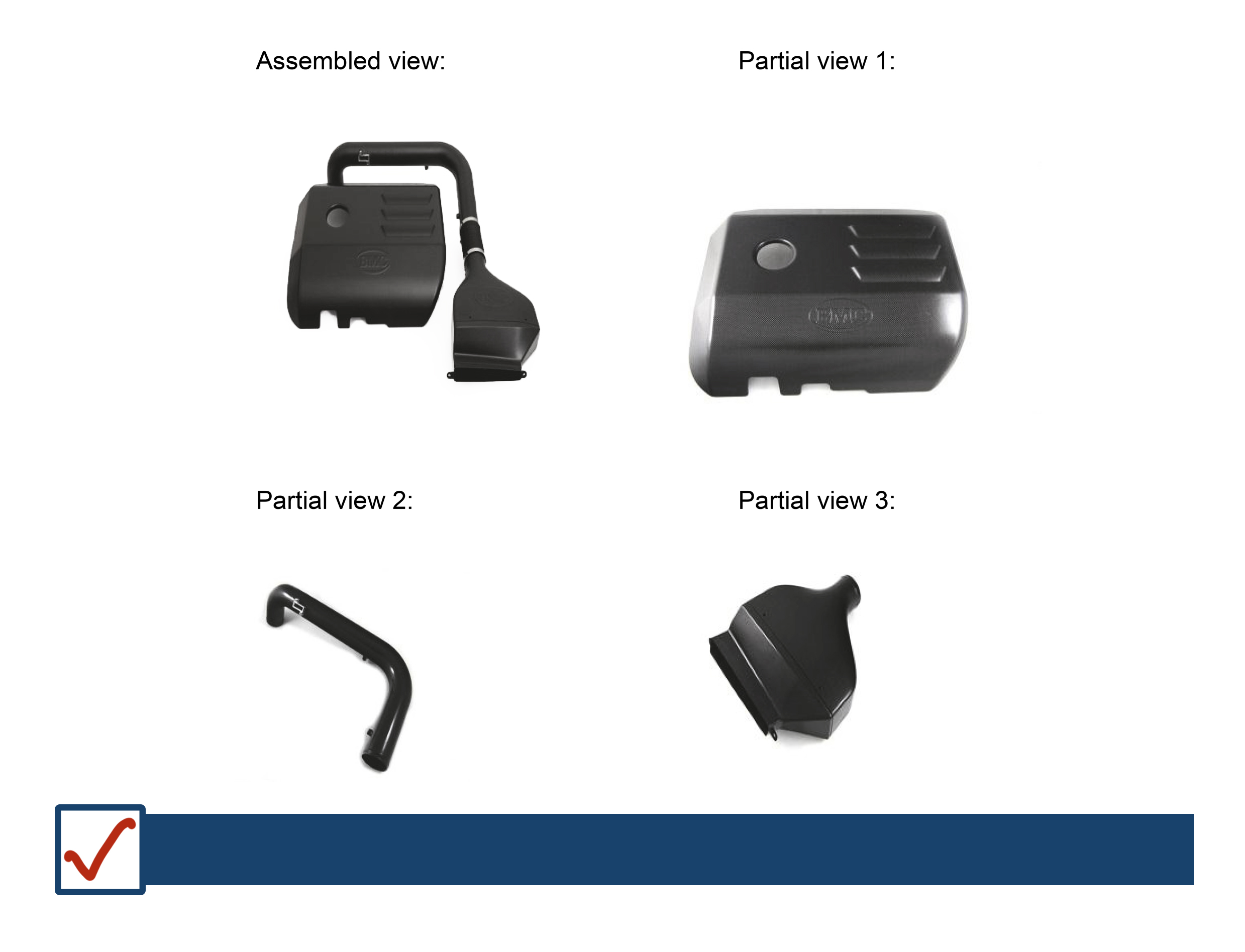
11.33
‘Sectional’ views show cross sections of ‘whole’ articles, and are used in order to complement more conventional aspect views by emphasising and illustrating a particular feature or features of the appearance of the product (for example, an article’s contour, surface or shape). As with other view ‘types’, sectional views should always be accompanied by a representation showing the article in its entirety. They should not include any technical information such as axial lines, dimensions, or numbers. The following example shows a conventional perspective view of a bath accompanied by a sectional view of the same article.

11.34
Graphical User Interfaces are most effectively represented via a single self-contained ‘screen shot’ of the static interface layout intended for protection. Two such examples are shown below:
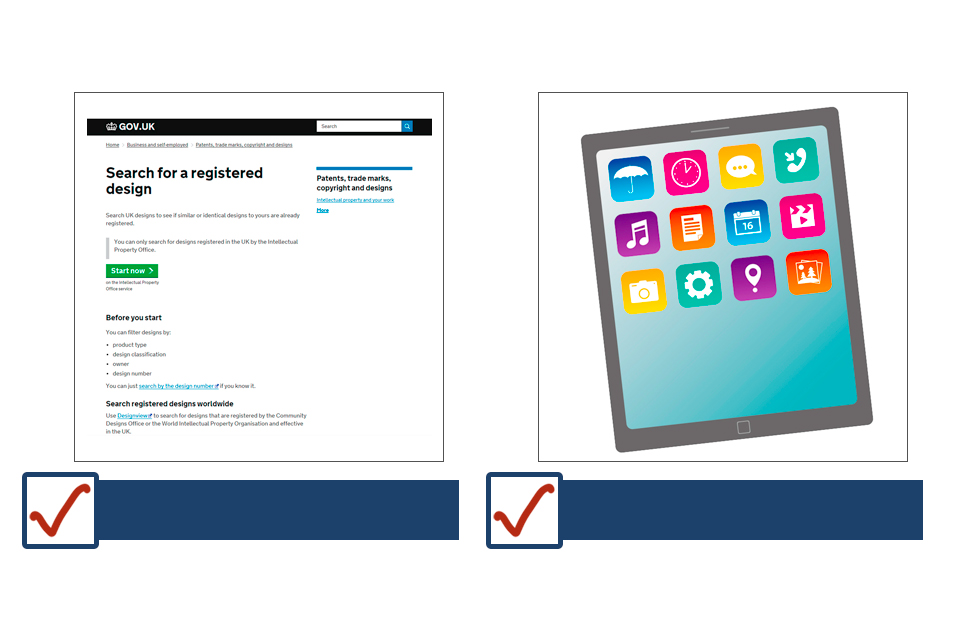
11.35
‘Snapshots’ can be used as a means of representing two-dimensional animated sequences (as opposed to static two-dimensional graphic elements or three-dimensional articles). They can include what are often referred to as ‘Graphical User Interfaces’ (or GUIs), meaning the visual configuration of graphic elements as they appear on a computer, tablet or smart phone screen (and the manner in which they move through a particular and self-contained animated sequence). In all such cases, up to twelve views can be used to show a single animated design at different specific points in time, and in a clearly defined progression. In order to represent such a sequence in the context of a Registered Design application, any and all views presented must be visually-related that is they must have features in common. The following two sets of representations are acceptable examples of ‘snapshot’-type representations, with the first showing the circular motion of a two-dimensional coloured bar as it moves in a circular fashion to create a horseshoe shape, and the second showing the movement of a light spot and a rectangular outline around a static grid:

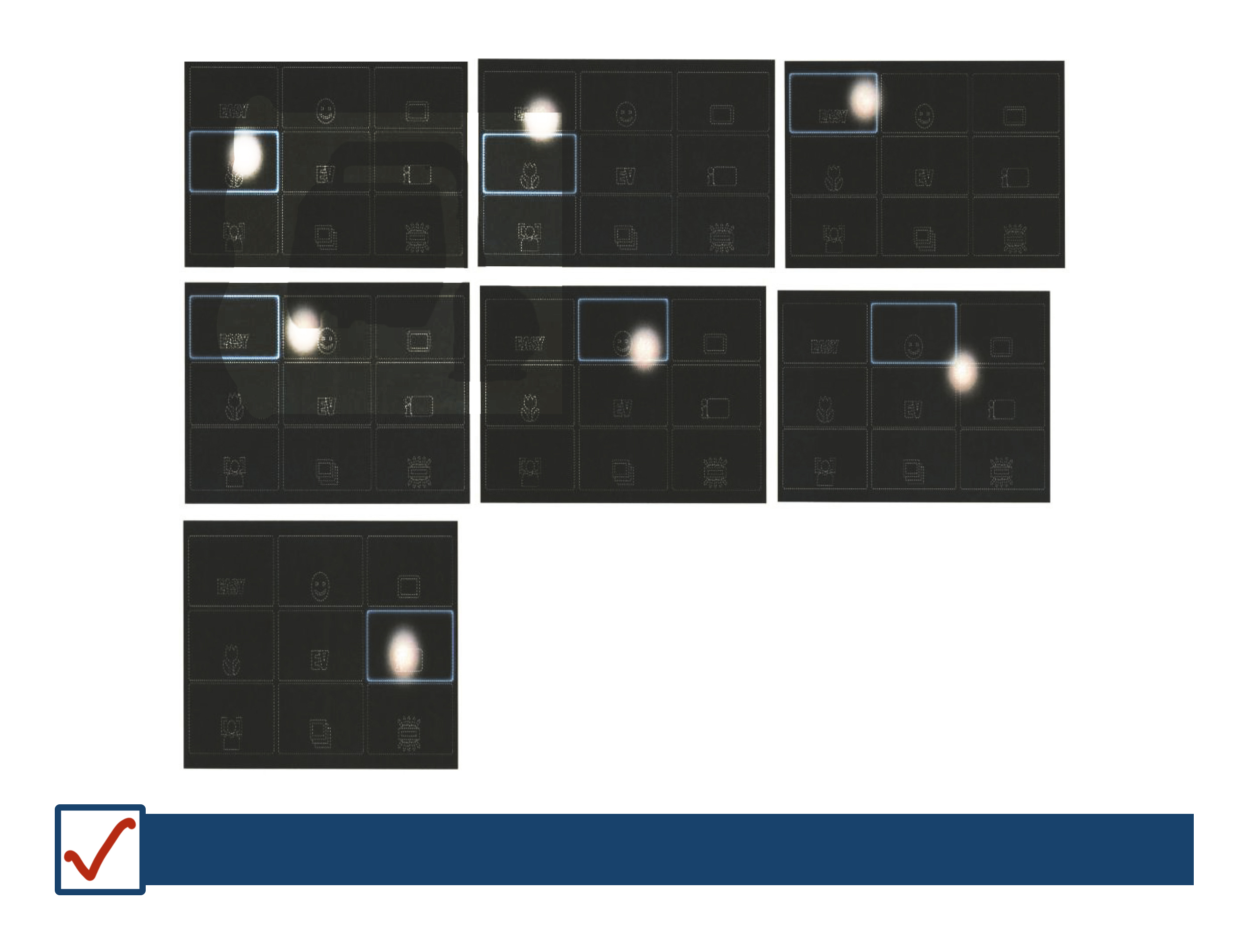
12.01
Rule 6 of the Registered Designs Rules 2006 permits applicants to use disclaimers to limit the scope of protection granted to particular aspects of a design (as opposed to the design in its entirety). The rule does not prescribe how a disclaimer should be presented in the application form and representations, meaning that the applicant has a choice of how best to show disclaimed elements. One method is to use graphic effects such as blurring, coloration or broken lines in order to distinguish those design aspects which are intended for protection from those which are not (a so-called ‘non-verbal’ or ‘visual’ disclaimer). Additionally, or alternatively, the applicant can enter explanatory text in a section provided on the application form (a so-called ‘verbal’ or ‘written’ disclaimer).
12.02
Whether verbal or non-verbal, it is essential that a disclaimer is clear to third parties in terms of describing what is and is not intended for protection as a Registered Design. Where the examiner determines that a submitted disclaimer is not clear, an objection will be raised under Rule 6, and a period of two months will be given in order that revised text or representations may be submitted. In respect of verbal/written disclaimers only, the examiner may propose alternative wording if it is reasonable to do so. However, the Registrar is under no obligation to provide such alternative wording for verbal disclaimers, and it remains the responsibility of the applicant to provide instructions in that regard (whether in the form of written agreement to alternative wording proposed by the examiner, or through the applicant’s own submission of an amended disclaimer).
12.03
Written disclaimers are acceptable provided they are clear, understandable, and correspond to the representation(s) submitted. Where, for example, colour or material is visible in a representation but is not intended to form any part of the registration, a written disclaimer may be necessary. This should always be recorded by the applicant within the appropriate section of the application form, and should be worded in accordance with the examples provided (for example “colour forms no part of the design”).
12.05
Visual disclaimers can be used either to specify the part(s) of the product for which design protection is being sought, or to indicate the part(s) which is not intended for protection. It should be noted that once a particular element of the design has been disclaimed, it cannot be used at a later date for the purposes of, for example, pursuing an infringement action.
12.06
The following guidance should assist applicants considering the use of such disclaimers
-
graphic or photographic representations showing only the claimed design are preferred
-
however, it is sometimes advantageous to show a design in context, and so some form of visual disclaimer may be necessary
-
the visual disclaimer must be clear and obvious from the graphic representations supplied, that is, there must be a clear, graphically-indicated distinction between the claimed and unclaimed features of the representation
-
although not compulsory, it may be useful in terms of defining the protection sought to accompany a visual disclaimer with a written disclaimer. Where both types of disclaimer are used in a single application, the written disclaimer should correspond exactly to the visual disclaimer shown in the representation (see paragraph 12.04 above)
12.07
Where representations are submitted in the form of line drawings, the Registrar recommends that broken lines are used as a means for visually disclaiming those parts of the design which are not intended for protection. In the following acceptable example, the outline shape of the sports shoe has been disclaimed via the use of broken lines; design protection is intended only for the ornamentation visible on the outer surface of the shoe, which has been shown in a solid continuous line:
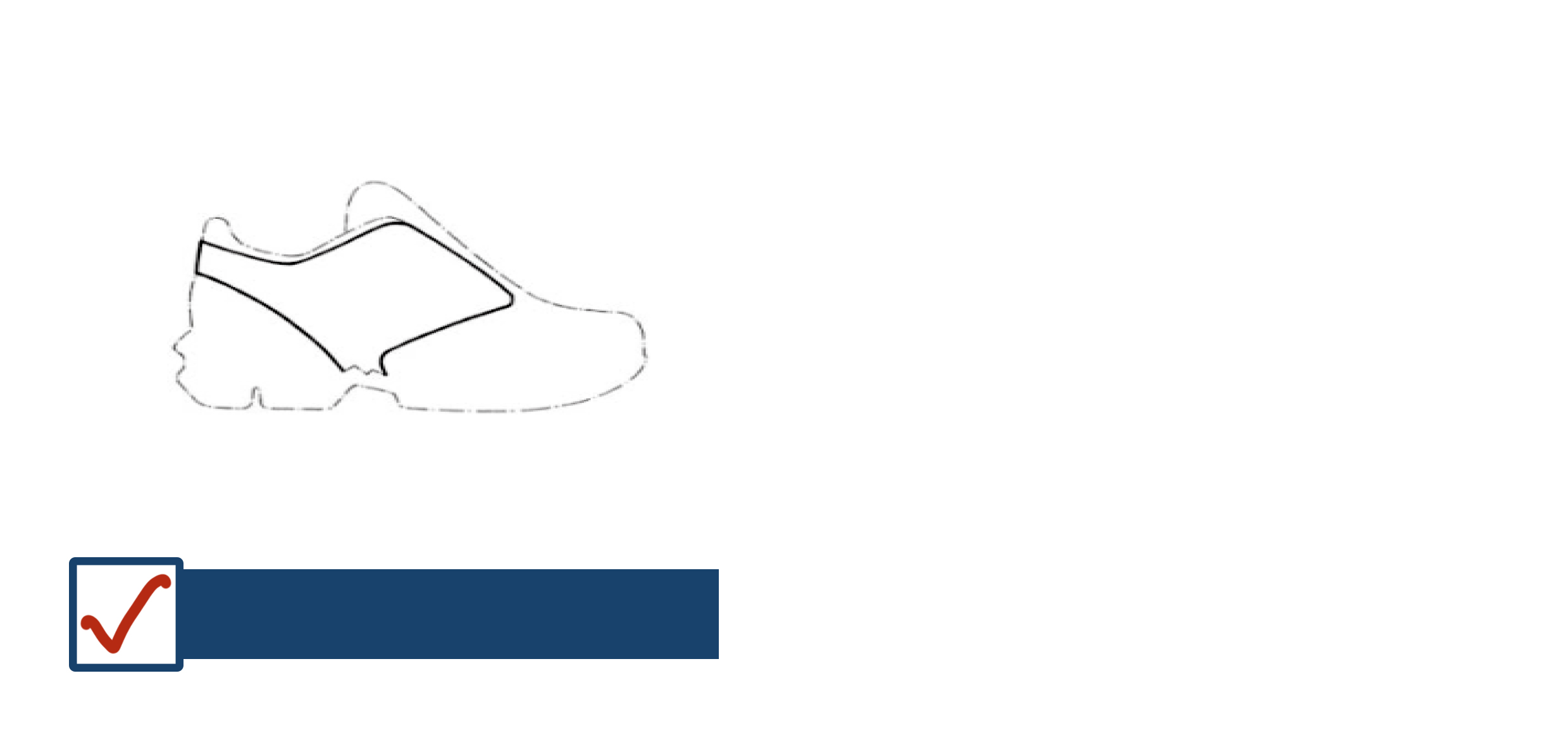
12.08
The two further examples shown below also demonstrate effective use of broken lines as non-verbal (or ‘visual’) disclaimers. In the first, protection is sought for the shape of a car mirror not withstanding its placement, in use, on a car door. In the second, protection is sought for the shape of a screwdriver handle, notwithstanding its appearance in use alongside the screwdriver bit. In all cases, it can be seen that a visual disclaimer consisting of broken lines functions effectively when those broken lines are used in combination with continuous (non-broken) lines):
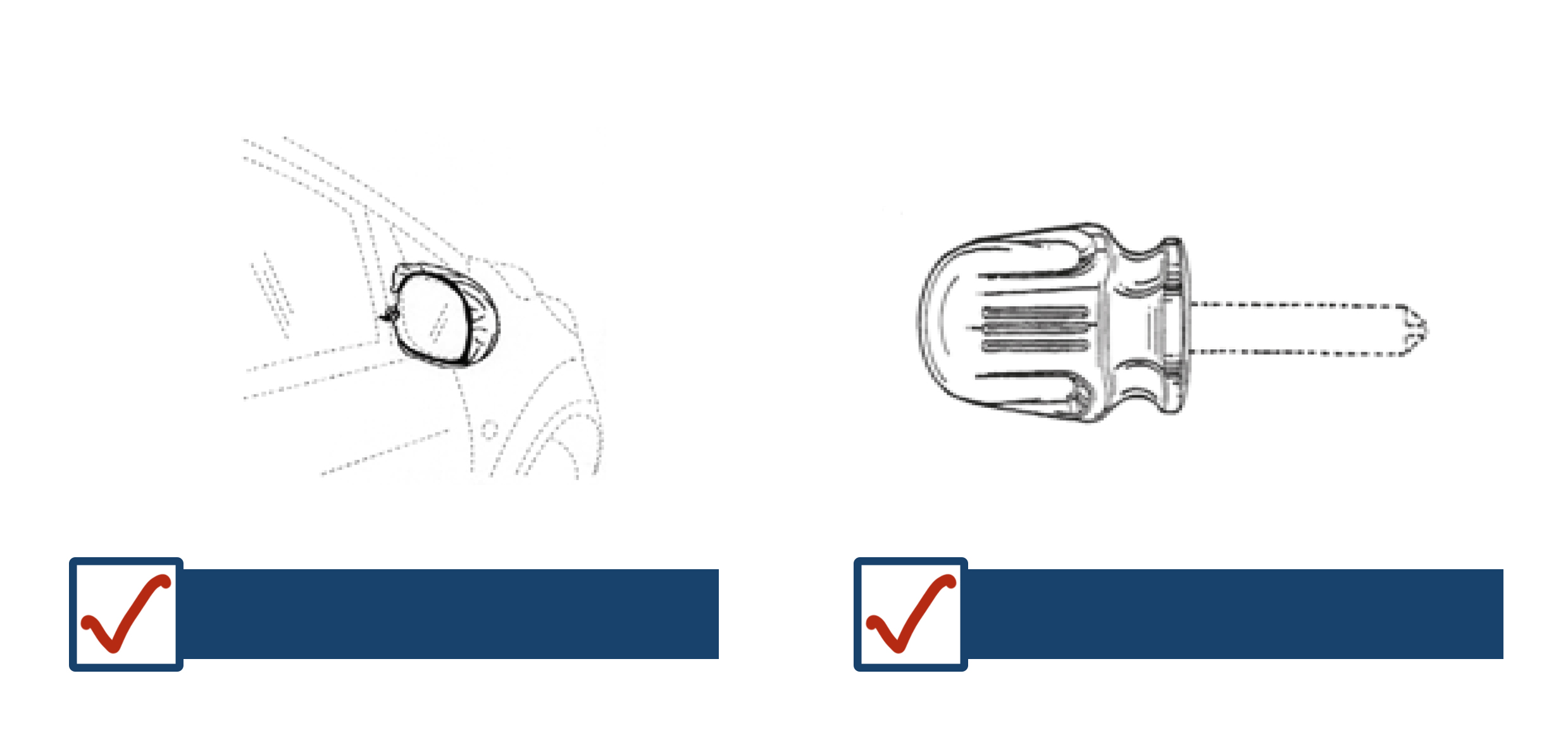
12.09
In those instances where broken lines cannot be used - for example, where broken or dotted lines intentionally appear within a design in order to represent the appearance of stitching in a clothing article, or where photographs have been submitted instead of line drawings - then the use of blurring, colour shading or figurative ‘boundaries’ is recommended. In the following example, which shows an article of clothing, the numerous broken lines are intended to form part of the design (for example, they represent a visible stitching pattern). They are not intended to be taken as a form of non-verbal disclaimer:

12.10
In order to visually disclaim a particular aspect of this design, the applicant’s intentional use of broken lines (as part of the design’s visible stitching) means an alternative means for visually disclaiming elements must be used. One way of doing this is to use circles and/or other simple geometric shapes in order to highlight those areas of the design intended for protection. In the acceptable example shown below, the use of a clear red circle placed around the central pocket feature signifies that design protection is intended to apply to that feature alone, rather than to the jumpsuit in its entirety:

12.11
‘Blurring’ is a type of visual disclaimer which consists of smearing out those features in a representation for which protection is not being sought. Where the technique is used, the disclaimed features must become vague or imperceptible, and must clearly contrast with the claimed (clearly defined) features for which protection is being sought. It must always be clear, from the representations, which features are being claimed and which are being disclaimed. The following is an example of acceptable blurring, where the (claimed) tread configuration of a vehicle tyre is shown in high resolution, and contrasted against the blurred outline of the (disclaimed) tyre shape per se.
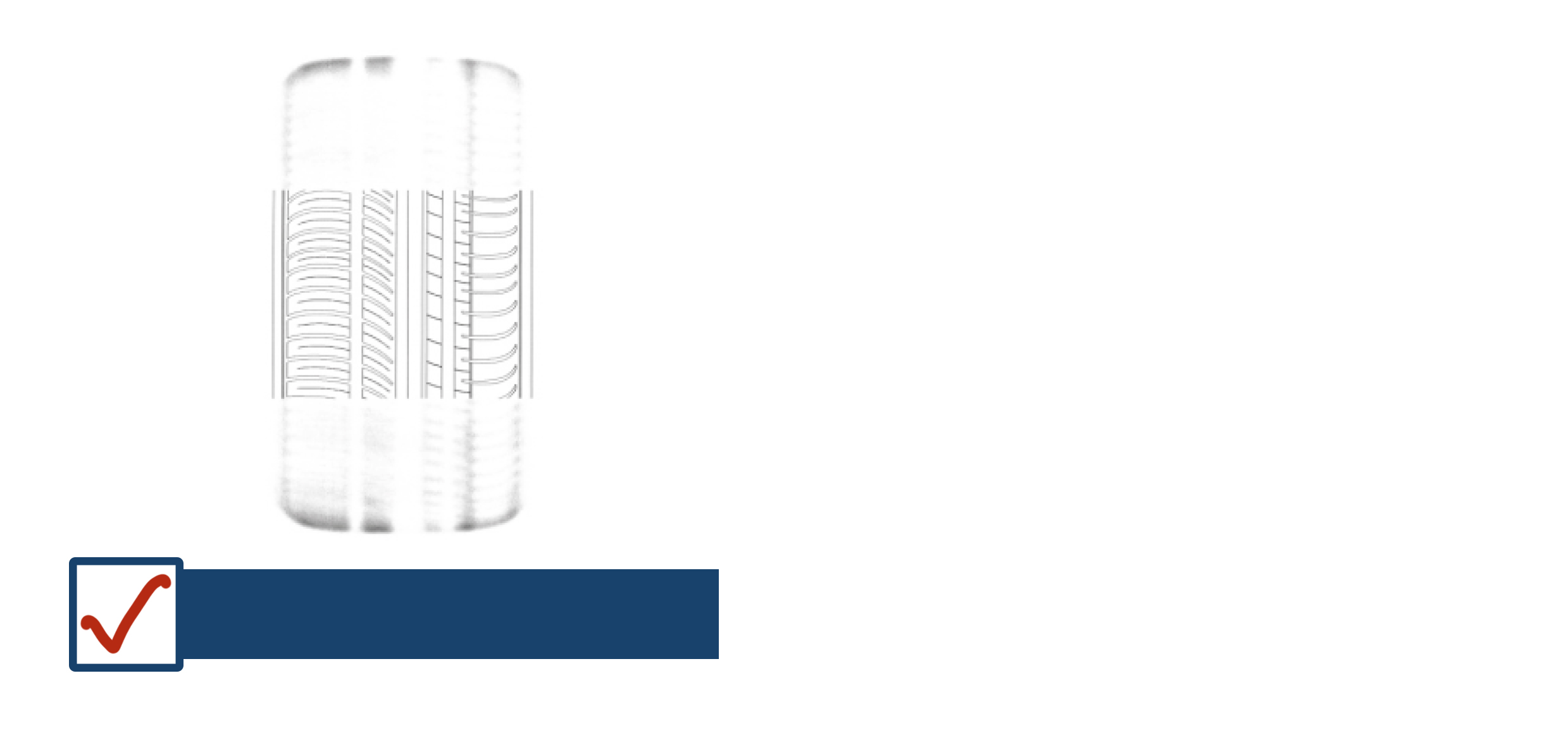
12.12
Colour (or tonal) shading is another visual disclaimer technique, where clear contrast in colour or tone can be used to distinguish between features which are being claimed and those which are not. Where used, the contrast and difference in colour or tonal shading must be sufficiently clear to avoid confusion as to what is and is not protected. The following is an example of acceptable colour shading, confirming that protection is sought only for the configuration of car bonnet, grille, headlights, bumper and front wing elements:

12.13
Circles (or ‘figurative boundaries’) are a type of visual disclaimer used in drawings or photographs to indicate that protection is sought only for those features which are contained within the circle or boundary. Unclaimed features found beyond the boundary or circle are considered to have a purely illustrative purpose by showing the context in which the claimed elements are located in use. In all cases, the features for which protection is sought must be clearly indicated within the circle or marked area. The following examples show acceptable use of circles and boundaries:

12.14
Care must be taken when using circles and boundaries in order to visually claim elements presented in line drawings and photographs. In all cases, the applicant should ensure that boundaries do not overlap into visual elements not intended for protection. In the first example shown below, the radiator grille of the motor home is intended for protection by way of the red circling (the others aspects of the vehicle design are intended to be disclaimed). However, position and presentation of the circle element means that it also includes other design features such as part of the headlamp design. Similarly, in the second example, the applicant’s attempt to visually disclaim all elements of the turntable design apart from the arm and stylus cartridge has been poorly presented. The circular element contains part of the arm, but also incorporates the mechanism onto which the arm is fixed along with part of the vinyl disc (neither of which are intended for protection). Furthermore, the stylus cartridge is outside of the circle device. In both cases, the examiner would seek clarification from the applicant as to what exactly is intended for protection, and would request amended representations.
